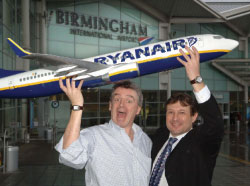
Pictured are Ryanair CEO Michael O’Leary and Peter Vella, business development director, Birmingham International Airport. Vella said: “The Ryanair base puts us back on a growth track to increase passenger numbers. It will enable us to sweat the assets a bit more.”
The new Ryanair base will grow from two dedicated aircraft in June 2008 to 10 by 2013, with 1.3 million passengers expected in the first year of operations. By 2013, it is forecast that the base will be generating an annual visitor spend of £400 million (€540m) and sustaining 5,000 jobs in the region, including skilled engineering jobs at the airport. Vella said: “This news is of very great significance to us. The regional market in the last five years has seen a shortfall and the volume is coming in the low-cost market. Low-cost carrier passengers are currently 50% of our total – that will probably increase to two thirds. Birmingham has been relatively slow in that market; passenger numbers have remained stable for the last few years. The Ryanair base puts us back on a growth track to increase passenger numbers. It will enable us to sweat the assets a bit more.”
Ryanair’s fleet of 189-seat 737-800s will also increase the average aircraft size in use at Birmingham International, carrying more passengers for less fuel burn and lower emissions per seat than many smaller, older aircraft types. The fact that the majority of routes will be new means that many passengers will not have to make a long and environmentally-unfriendly journey outside the region to access air travel. This is in line with the airport’s commitment to support the UK Government’s White Paper on Aviation, which indicated that demand for air travel should be satisfied in a sustainable manner. The new routes will help Birmingham International to serve its natural catchment area, rather than potential passengers driving to London Heathrow, London Stansted or Manchester Airport, for example.
Birmingham International currently has a 36% market share within its catchment area, a figure it is obviously looking to increase. “We are starting from a position behind where we think we should be. Eight million people live within a one-hour drive of the airport; we are in a competitive market and location,” said Vella.
Proposed runway extension
The five million passengers Ryanair will generate is a significant increase on the 9.3 million passengers that presently use the airport each year, but it is in line with forecasts contained in its Master Plan to 2030, which was launched in November 2007. “Our Master Plan does show big growth and Ryanair is part of that. The base will perhaps bring growth earlier, but it will ultimately fall in line with the curve of the Master Plan,” said Vella.
The prediction is that throughput will reach 18 million passengers by 2018 and 27 million by 2030. The airport has also applied for planning permission for a runway extension, which if approved, would open in late 2011/2012. The runway is currently 2,600m long and the proposal is to extend it by 405m to accommodate larger aircraft and provide opportunities for more long-haul routes. “We are currently restricted to the east coast of the US – Continental operates a service to New York Newark. Beyond that, it becomes a problem. We have lost a bit of business because of this. Going east, we can get to the eastern coast of the Indian subcontinent,” said Vella. He sees particular potential for services to India and the Far East.







